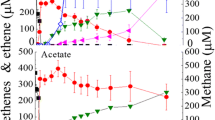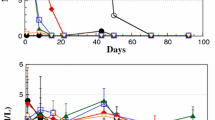Abstract
Methylocystis strain SB2, a facultative methanotroph capable of growth on multi-carbon compounds, was screened for its ability to degrade the priority pollutants 1,2-dichloroethane (1,2-DCA), 1,1,2-trichloroethane (1,1,2-TCA), and 1,1-dichloroethylene (1,1-DCE), as well as cis-dichloroethylene (cis-DCE) when grown on methane or ethanol. Methylocystis strain SB2 degraded 1,2-DCA and 1,1,2-TCA when grown on either substrate and cis-DCE when grown on methane. Growth of Methylocystis strain SB2 on methane was inhibited in the presence of all compounds, while only 1,1-DCE and cis-DCE inhibited growth on ethanol. No degradation of any chlorinated hydrocarbon was observed in ethanol-grown cultures when particulate methane monooxygenase (pMMO) activity was inhibited with the addition of acetylene, indicating that competition for binding to the pMMO between the chlorinated hydrocarbons and methane limited both methanotrophic growth and pollutant degradation when this strain was grown on methane. Characterization of Methylocystis strain SB2 found no evidence of a high-affinity form of pMMO for methane, nor could this strain utilize 1,2-DCA or its putative oxidative products 2-chloroethanol or chloroactetic acid as sole growth substrates, suggesting that this strain lacks appropriate dehydrogenases for the conversion of 1,2-DCA to glyoxylate. As ethanol: (1) can be used as an alternative growth substrate for promoting pollutant degradation by Methylocystis strain SB2 as the pMMO is not required for its growth on ethanol and (2) has been used to enhance the mobility of chlorinated hydrocarbons in situ, it is proposed that ethanol can be used to enhance both pollutant transport and biodegradation by Methylocystis strain SB2.
Similar content being viewed by others
References
Baani M, Liesack W (2008) Two isozymes of particulate methane monooxygenase with different methane oxidation kinetics are found in Methylocystis sp strain SC2. Proceed Nat Acad Sciences 105:10203–10208
Belova SE, Baani M, Suzina NE, Bodelier PLE, Liesack W, Dedysh SN (2011) Acetate utilization as a survival strategy of peat-inhabiting Methylocystis spp. Environ Microbiol Rep 3:36–46
Blanksby SJ, Ellison GB (2003) Bond dissociation energies of organic molecules. Acc Chem Res 36:255–263
Chang HL, Cohen LA (1996) Biodegradation of individual and multiple chlorinated aliphatic hydrocarbons by methane-oxidizing cultures. Appl Environ Microbiol 62:3371–3377
Dalton H, Stirling DI (1982) Co-metabolism. Phil Trans R Soc Lond 297:481–496
Dedysh SN, Knief C, Dunfield PF (2005) Methylocella species are facultatively methanotrophic. J Bacteriol 187:4665–4670
Dedysh SN, Panikov NS, Tiedje JM (1998) Acidophilic methanotrophic communities from sphagnum peat bogs. Appl Environ Microbiol 64:922–929
Dunfield PF, Belova SE, Vorob’ev AV, Cornish SL, Dedysh SN (2010) Methylocapsa aurea sp. nov., a facultative methanotroph possessing a particulate methane monooxygenase and emended description of the genus Methylocapsa. Intl J Syst Evol Microbiol 60:2659–2664
Folkard GK (1986) The significance, occurrence and removal of volatile chlorinated hydrocarbon solvents in groundwaters. Wat Pollut Control 85:63–70
Hage JC, Hartmans S (1999) Monooxygenase-mediated 1,2-dichloroethane degradation by Pseudomonas sp. strain DCA1. Appl Environ Microbiol 65:2466–2470
Han JI, Semrau JD (2000) Chloromethane stimulates growth of Methylomicrobium album BG8 on methanol. FEMS Microbiol Lett 187:77–81
Im J, Semrau JD (2011) Pollutant degradation by a Methylocystis strain SB2 grown on ethanol: bioremediation via facultative methanotrophy. FEMS Microbiol Lett 318:137–142
Im J, Lee SW, Yoon S, DiSpirito AA, Semrau JD (2011) Characterization of a novel facultative Methylocystis species capable of growth on methane, acetate and ethanol. Environ Microbiol Rep 3:174–181
Janssen DB, van der Ploeg JR, Pries F (1994) Genetics and biochemistry and 1,2-dichloroethane degradation. Biodegradation 5:249–257
Janssen DB, Scheper A, Dijkhuizen D, Witholt B (1985) Degradation of halogenated aliphatic compounds by Xanthobacter autotrophicus GJ10. Appl Environ Microbiol 49:673–677
Lee SW, Keeney DR, Lim DH, DiSpirito AA, Semrau JD (2006) Mixed pollutant degradation by Methylosinus trichosporium OB3b expressing either soluble or particulate methane monooxygenase: can the tortoise beat the hare? Appl Environ Microbiol 72:7503–7509
Murrell JC, McDonald IR, Gilbert B (2000) Regulation of expression of methane monooxygenases by copper ions. Trends Microbiol 8:221–225
Paszczynski AJ, Paidisetti R, Johnson AK, Crawford RL, Colwell FS, Green T, Delwiche M, Lee H, Newby D, Brodie EL, Conrad M (2011) Proteomic and targeted qPCR analyses of subsurface microbial communities for presence of methane monooxygenase. Biodeg 22:1045–1059
Rahman MT, Crombie A, Moussard H, Chen Y, Murrell JC (2011) Acetate repression of methane oxidation by supplemental Methylocella silvestris in a peat soil microcosm. Appl Environ Microbiol 77:4234–4236
Ramakrishnan V, Ogram AV, Lindner A (2005) Impacts of co-solvent flushing on microbial populations capable of degrading trichloroethylene. Environ Health Persp 113:55–61
Semrau JD, DiSpirito AA, Yoon S (2010) Methanotrophs and copper. FEMS Microbiol Rev 34:496–531
Semrau JD (2011) Bioremediation via methanotrophy: overview of recent findings and suggestions for future research. Front Microbiol 2:1–7
Shukla AK, Vishwakarma P, Upadhyay SN, Tripathi AK, Prasana HC, Dubey SK (2009) Biodegradation of trichloroethylene (TCE) by methanotrophic community. Biores Technol 100:2469–2474
Taylor TP, Rathfelder KM, Pennell KD, Abriola LM (2004) Effects of ethanol addition on micellar solubilization and plume migration during surfactant enhanced recovery of tetrachloroethene. J Contam Hydrology 69:73–99
Theisen AR, Ali MH, Radajewski S, Dumont MG, Dunfield PF, McDonald IR, Dedysh SN, Miguez CB, Murrell JC (2005) Regulation of methane oxidation in the facultative methanotroph Methylocella silvestris BL2. Mol Microbiol 58:682–692
Tse G, Orbey H, Sandler SI (1992) Infinite dilution activity coefficients and Henry’s law coefficients of some priority water pollutants determined by a relative gas chromatographic method. Environ Sci Technol 26:2017–2022
van den Wijngaard AJ, Prins J, Smal AJAC, Janssen DB (1993) Degradation of 2-chloroethylvinylether by Ancylobacter aquaticus AD25 and AD27. Appl Environ Microbiol 59:2777–2783
van den Wijngaard AJ, van der Kamp WHJ, van der Ploeg J, Pries F, Kazemier B, Janssen DB (1992) Degradation of 1,2-dichloroethane by Ancylobacter aquaticus and other facultative methylotrophs. Appl Environ Microbiol 58:976–983
Van Hylckama Vlieg JET, Koning W, Janssen DB (1997) Effect of chlorinated ethene conversion on viability and activity of Methylosinus trichosporium OB3b. Appl Environ Microbiol 63:4961–4964
Whittenbury R, Phillips KC, Wilkinson JF (1970) Enrichment, isolation and some properties of methane-utilizing bacteria. J Gen Microbiol 61:205–218
Yimga MT, Dunfield PF, Ricke P, Heyer J, Liesack W (2003) Wide distribution of a novel pmoA-like gene copy among type II methanotrophs, and its expression in Methylocystis strain SC2. Appl Environ Microbiol 69:5593–5602
Yoon S, Im J, Bandow N, DiSpirito AA, Semrau JD (2011) Constitutive expression of pMMO by Methylocystis strain SB2 when grown on multi-carbon substrates: implications for biodegradation of chlorinated ethenes. Environ Microbiol Rep 3:182–188
Acknowledgments
This research was supported by the Office of Science (BER) US Department of Energy. We dedicate this manuscript to the memory of Professor Sir Howard Dalton, FRS (1944–2008) on the 30th anniversary of his construction of the definition of co-metabolism.
Author information
Authors and Affiliations
Corresponding author
Electronic supplementary material
Below is the link to the electronic supplementary material.
ESM 1
(PDF 270 kb)
Rights and permissions
About this article
Cite this article
Jagadevan, S., Semrau, J.D. Priority pollutant degradation by the facultative methanotroph, Methylocystis strain SB2. Appl Microbiol Biotechnol 97, 5089–5096 (2013). https://doi.org/10.1007/s00253-012-4310-y
Received:
Revised:
Accepted:
Published:
Issue Date:
DOI: https://doi.org/10.1007/s00253-012-4310-y




